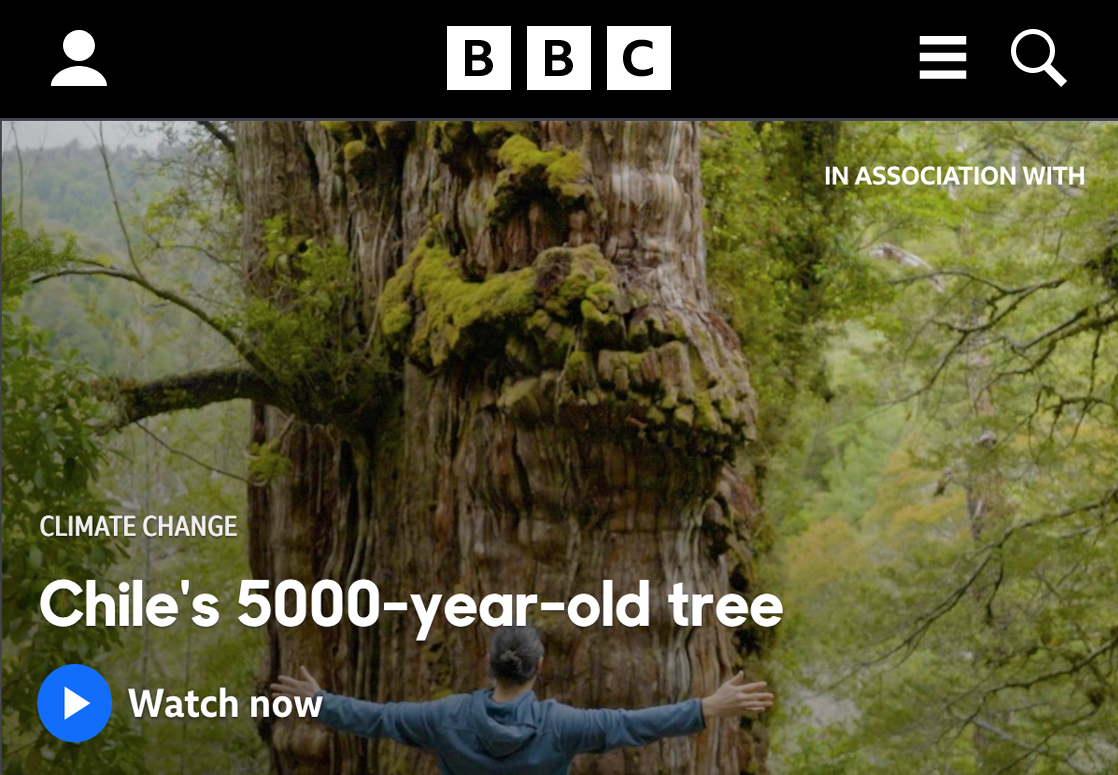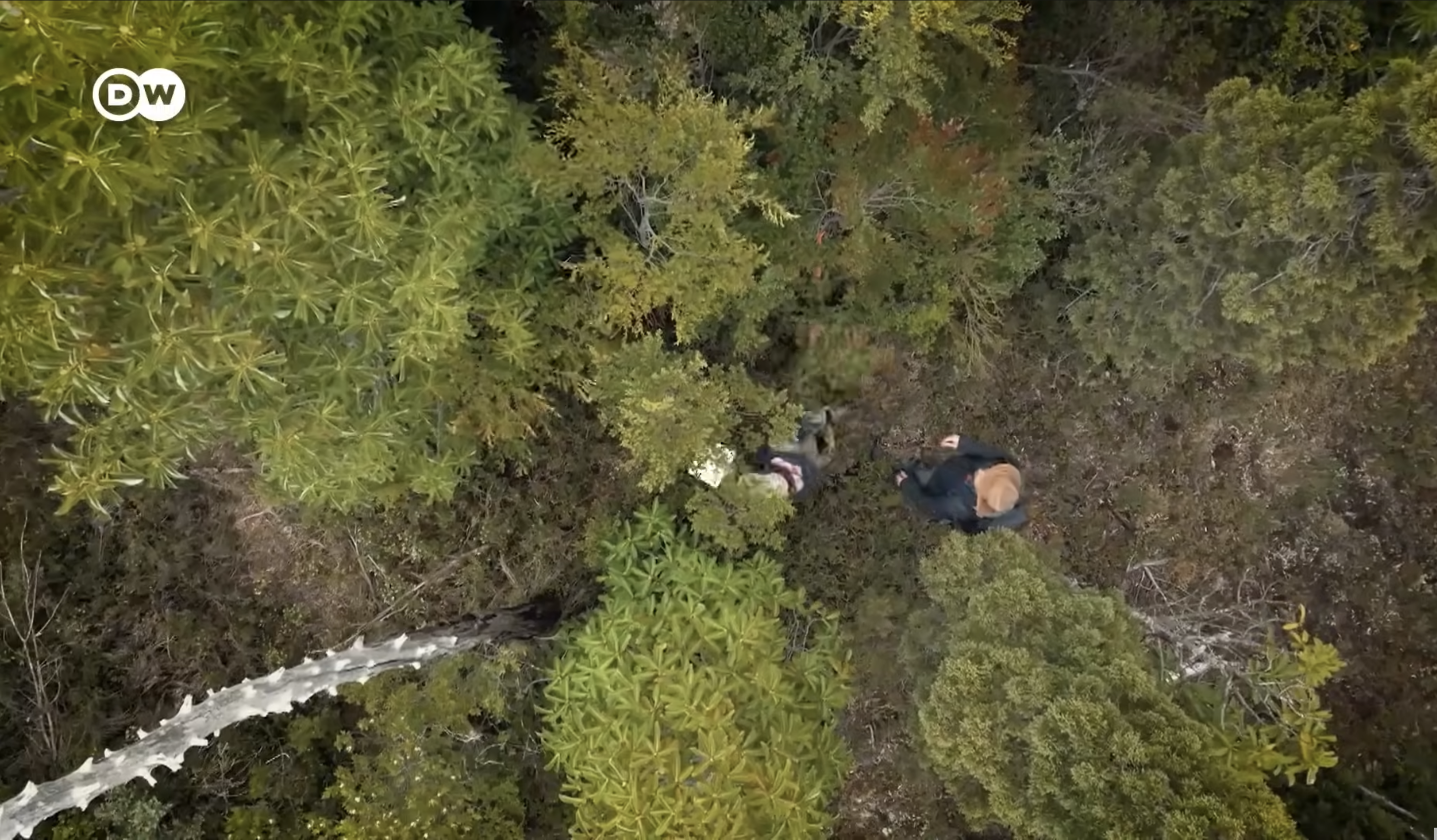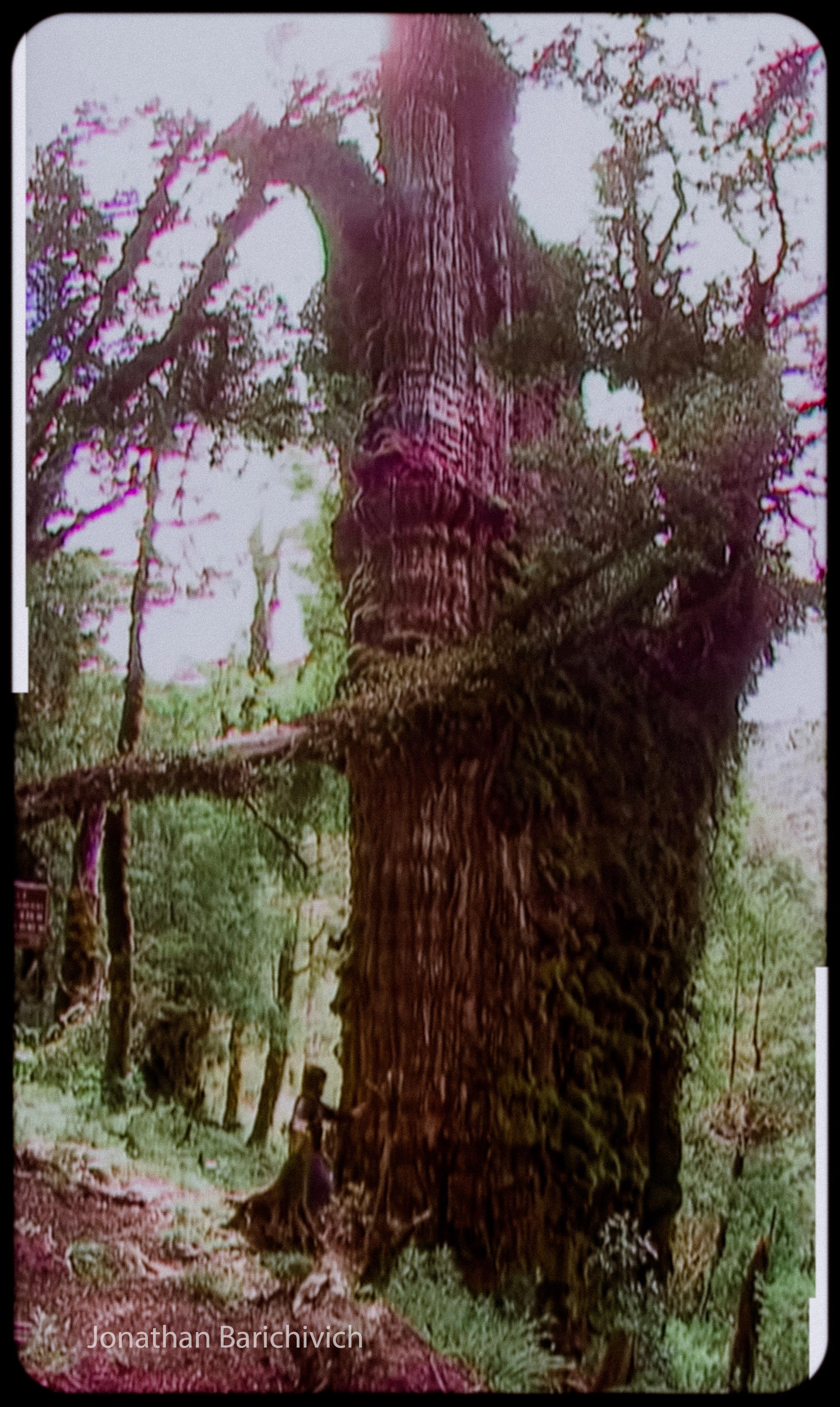Dr. Jonathan Barichivich
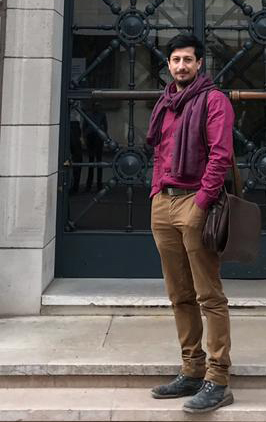
Global climate and ecosystem science
See me in GoogleScholar
Research portfolio
Bio
I integrate measurements and models to reconstruct and predict the interactions between terrestrial ecosystems and the climate system from days to centuries. The final aim of my research is to anticipate the impacts of global change on living conditions and particularly on the terrestrial critical zone - the fragile planetary layer that sustains our increasingly pressuring and polarised societies. To achieve this I work across components of the Earth System, collect my own data to improve models and collaborate with colleagues from around the world. My publications and their impact can be found in GoogleScholar.
I hold an MSc in Climate Change and a PhD in Environmental Sciences from the world renowned Climatic Research Unit (CRU) of the University of East Anglia, UK.
I am Research Professor (Directeur de Recherche) in the Centre National de la Recherche Scientifique (CNRS). I am based at the Laboratoire des Sciences du Climat et de l’Environnement (LSCE) in Paris, France. In 2021 I was awarded an ERC-stg to improve the ecology of the terrestrial component of the IPSL Earth System model using tree rings.
My research team is distributed in France (LSCE), UK (CRU and University of Leeds) and South America (Austral University of Chile, University of Chile, Pontificial Catholic University of Valparaíso). Here I collaborate with colleagues on pressing global change questions using a diverse set of observations and models.
My work in the media
BBC Climate Change: The 5,000-year-old tree that holds clues to life and death, 2023.
Deutsche Welle: Protecting Lañilawal, 2025.
- Coverage of our science-art collaboration Lañilawal in Ars Electronica 2022 - Welcome to Planet B, Linz, Austria, 7-11 September 2022.
- Opinion piece in El Mostrador about the need to conserve the remarkable trees in the Chilean rainforest, 10 September 2022.
- Feature in ScienceInsider: Plants & Animals about the ancient Alerce Milenario tree growing in the Chilean rainforest, May 2022. It has been covered by NewsWeek, BBC, The World, CBC, National Geographic, Aljazeera and The Guardian among many other media outlets around the world.
- My research findings on Amazon climate change have been quoted by Sir David Attenborough in the BBC documentaries A perfect planet: weather (2020) and Earth’s great rivers: Amazon (2021).
- Feature in nature documentary Historias de Arboles: el grandioso alerce, March 2020, Canal 13C, Chile.
- Feature in nature documentary Tráfico Ilícito: alerce, April 2020, La Red TV Chanel, Chile.
- Mongabay, Extreme flooding in Ecuador, May 2020.
- Mongabay, Flooding changes in Amazonia, December 2018.
- BBC News Mundo, interview about floods in Amazonia.
- El Pais Newspaper (Spain), interview about floods in Amazonia.
- Reuters, interview about floods in Amazonia.
- Feature in nature documentary Expedição Água: rios voadores (Amazônia), Globo TV, Brazil.
- NewScientist. Feature interview The Great Greening by O. Heffernan.
Recent awards & achievements
2022 Laureate of the ERC starting grant 2021 with the proposal Long-term consequences of altered tree growth and physiology in the Earth System (CATES).
2019–2021 Laureate of the French presidential program of scientific research Make Our Planet Great Again (MOPGA), Paris, France.
ERC starting grant CATES
1.5 M€ to improve climate change projections using the memory of the world’s trees in 5 years (2022–2026)
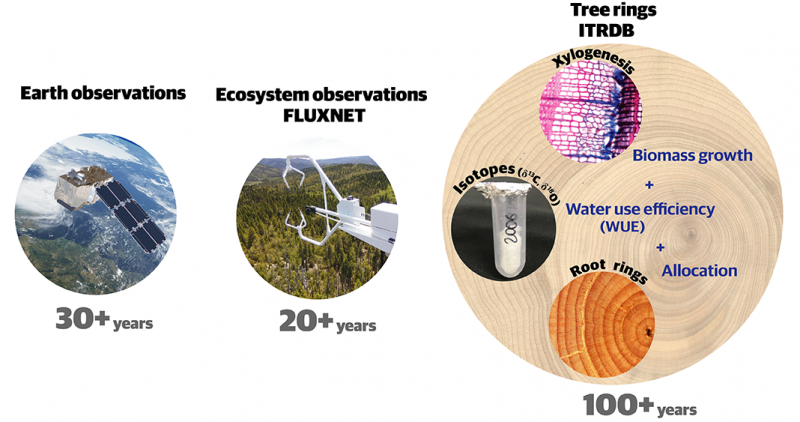
WE ARE HIRING. More information here:
Latest research
The ancient Alerce Milenario monumental tree in southern Chile is LIKELY more than 5000 years old. This would make it ONE of the oldest LIVING trees on Earth as commented in Science. The paper is coming.
Latest talk
Invited Talk, 50th Anniversary of the Climatic Research Unit (CRU), Norwich, UK
Latest datasets
- 2023: CL-ACF data package v1.0: Daily micrometeorology and carbon fluxes of the Ameriflux eddy covariance site CL-ACF in the Alerce Costero National Park, Chile for the period 2018-2021
- 2022: Global self-calibrating Palmer Drought Severity Index dataset 1901-2021 (CRUTS-scPDSI)
- 2021: Triple tree-ring constraint for models (data and code)
- 2021: High-resolution drought Atlas for the Southern Andes (SADITA)
- 2021: South American Drought Atlas (SADA)
- 2020: Simulations from the ORCHIDEE dynamic global vegetation model for the Vegetation Carbon Turnover Intercomparison
Experimental sites
Science for people
Renaturalización
Renaturalización, un pacto con la naturaleza para recuperar el agua.
Citizen science
OPEN SCIENCE
Perez-Quezada, J., Barichivich, J. et al. “Warming and drought weaken the carbon sink capacity of an endangered paleoendemic temperate rainforest in South America.”. JGR: Biogeosciences, [2023]. Research highlighted in the cover of JGR: Biogeosciences Vol 128, Issue 4
Urrutia-Jalabert, R., Barichivich, J. et al. “Ecophysiological responses of Nothofagus obliqua forests to recent climate drying across the Mediterranean-Temperate biome transition in south-central Chile”. JGR: Biogeosciences, [2023]. Research Spotlight in EOS: Short-Lived Solutions for Tall Trees in Chile’s Megadrought
Research areas
a. Global climate and extremes
One of my primary research activities is on advancing our understanding of processes driving global climate anomalies (climate dynamics) and their feedbacks with the functioning of terrestrial ecosystems (global ecology).
In a recent work we revealed how the intensification of tropical Walker circulation has driven the observed intensification of the hydrological cycle of the Amazon basin. Contrary to the prevailing view on catastrophic drought in the basin, my research showed that flooding is the hydrological feature that has changed most in recent decades. The frequency of severe floods has increased 5-fold since 1960 because of intensified atmospheric circulation and water vapour transport from a warming tropical Atlantic Ocean. In June 2021, the water level of the Amazon river (Rio Negro) in Manaus reached the highest value ever (30.02 m) in the 120 years of daily records.
My findings have been quoted by Sir David Attenborough in the BBC documentaries A perfect planet: weather and Earth’s great rivers: Amazon. A forthcoming documentary production on wildlife of “The Americas” will further highlight these findings.
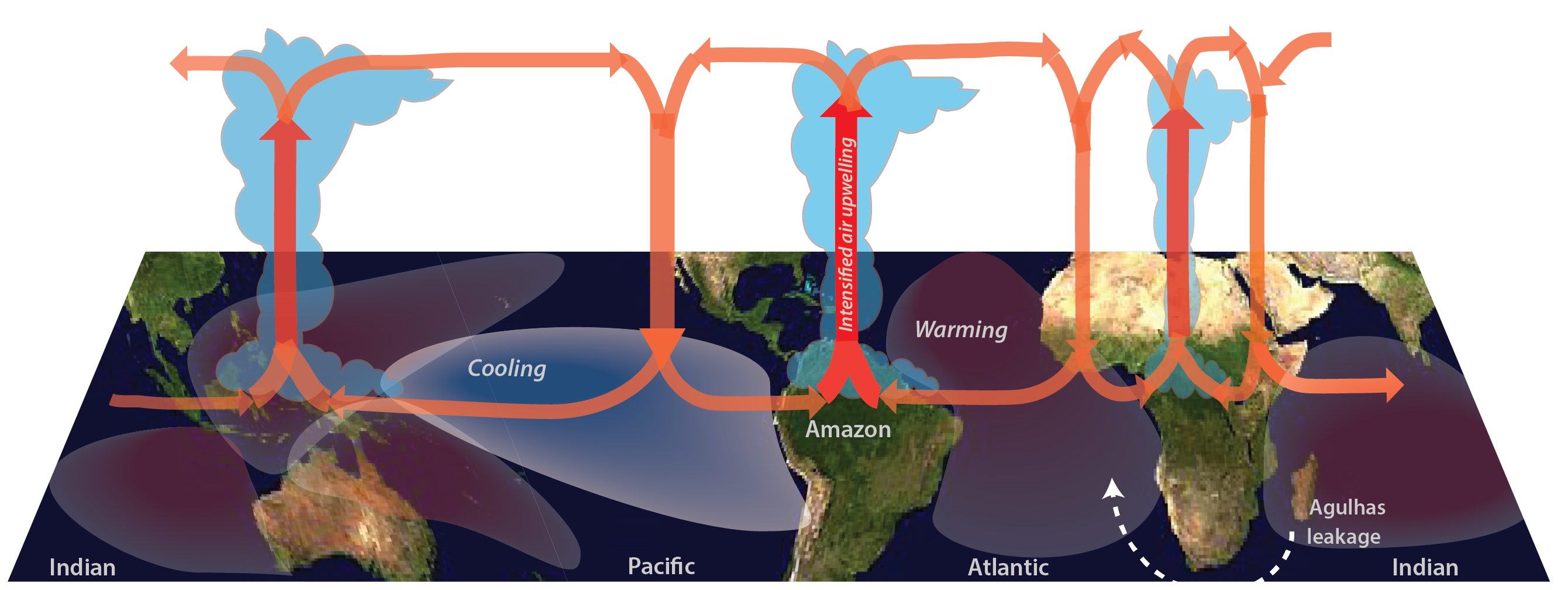
The acceleration of the global Walker circulation and unprecedented flooding in Amazonia as reported by Barichivich et al. (2018).
b. Reconstructing and monitoring global drought
As part of my work as Associate Fellow in CRU, I lead the yearly assessment of global drought since 2015 in the State of the Climate supplement of the Bulletin of the American Meteorological Society. We provide an annual update of drought extent, severity and location from 1901 based on the self-calibrating Palmer Drought Severity Index (scPDSI) computed using the gridded climate fields from the CRU TS dataset.
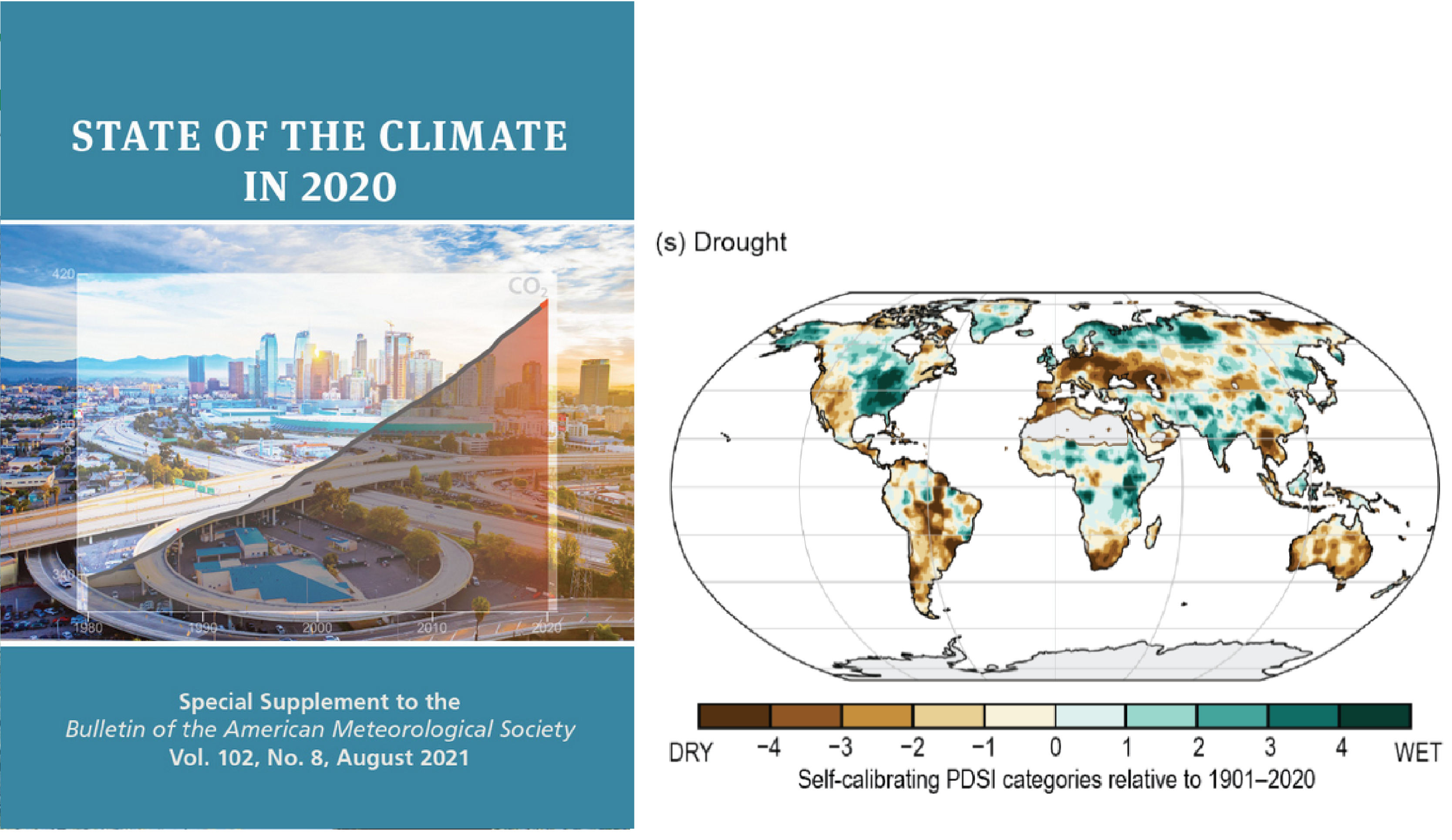
Monitoring global drought using the self-calibrating Palmer Drought Severity Index for BAMS State of the Climate in 2020.
Beside maintaining the instrumental record of global drought, I also reconstruct past drought variability (scPDSI) in space and time using networks of tree-ring records in order to produce drought atlases that can be compared with climate model simulations. I am particularly interested in producing high-resolution drought atlases for sensitive regions at the scale of 5–10 km. The reconstructed maps can be analysed to characterise the spatial extent and severity of past droughts, quantify their impacts on society and ecosystems, and study the mechanisms that cause the different types of droughts (e.g., interannual, multiannual, megadroughts, compound extreme droughts).
c. Monitoring and modelling terrestrial ecosystems in the critical zone
The global ecology component of my research relies on monitoring and modelling of the water and carbon cycle of forest ecosystems in the context of the critical zone. I design and collect my own obervations to advance current process-based understanding in critical areas and improve models useful at different scales. This allows me to pose and answer scientific questions at the forefront of the field.

Conceptual diagram of my research program to advance current process-based understanding and projection of long-term responses of forest growth and physiology to global change.
My effort on ecosystem monitoring has been dedicated to the establishment of an observatory of the critical zone in the temperate rain forests of South America as a model to understand the responses of the terrestrial critical zone to climate drying from an integrated above-and below-ground perspective. This biome is undergoing a dramatic drying due to the poleward migration of the storm tracks with climate change and is therefore especially suited to study long-term responses of temperate forests to drought and raising CO2 concentrations under undisturbed nitrogen cycling.
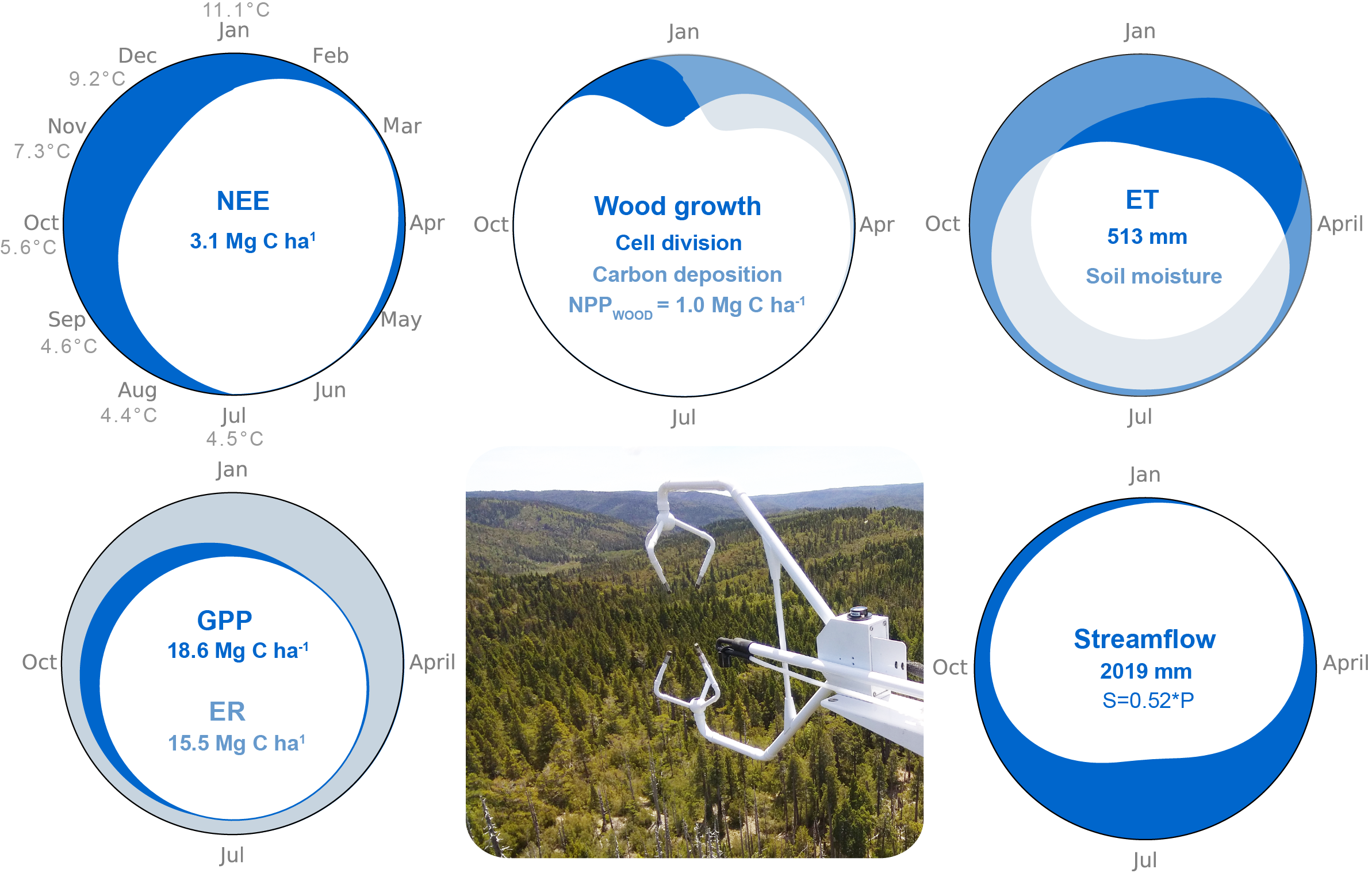
Biological clocks of a coniferous rainforest ecosystem in southern Chile as revealed by simultaneous eddy covariance and cambial growth monitoring.
d. Improving global land surface models at long time scales
This innovative research line is at the crossroads of climate and ecology. It draws on my unique skill set across different components of the Earth system. I seek to develop a new cross-disciplinary framework to constrain climate projections by jointly improving the simulation of forest growth and water use at long time scales (decades to century) using novel observational constraints for historical growth and physiology derived from tree-ring data. This involves developing novel uses of tree-ring data (e.g., triple tree-ring constraint pictured below) and updating the biology of tree growth in global land surface models to integrate the so-called source-sink growth paradigms.
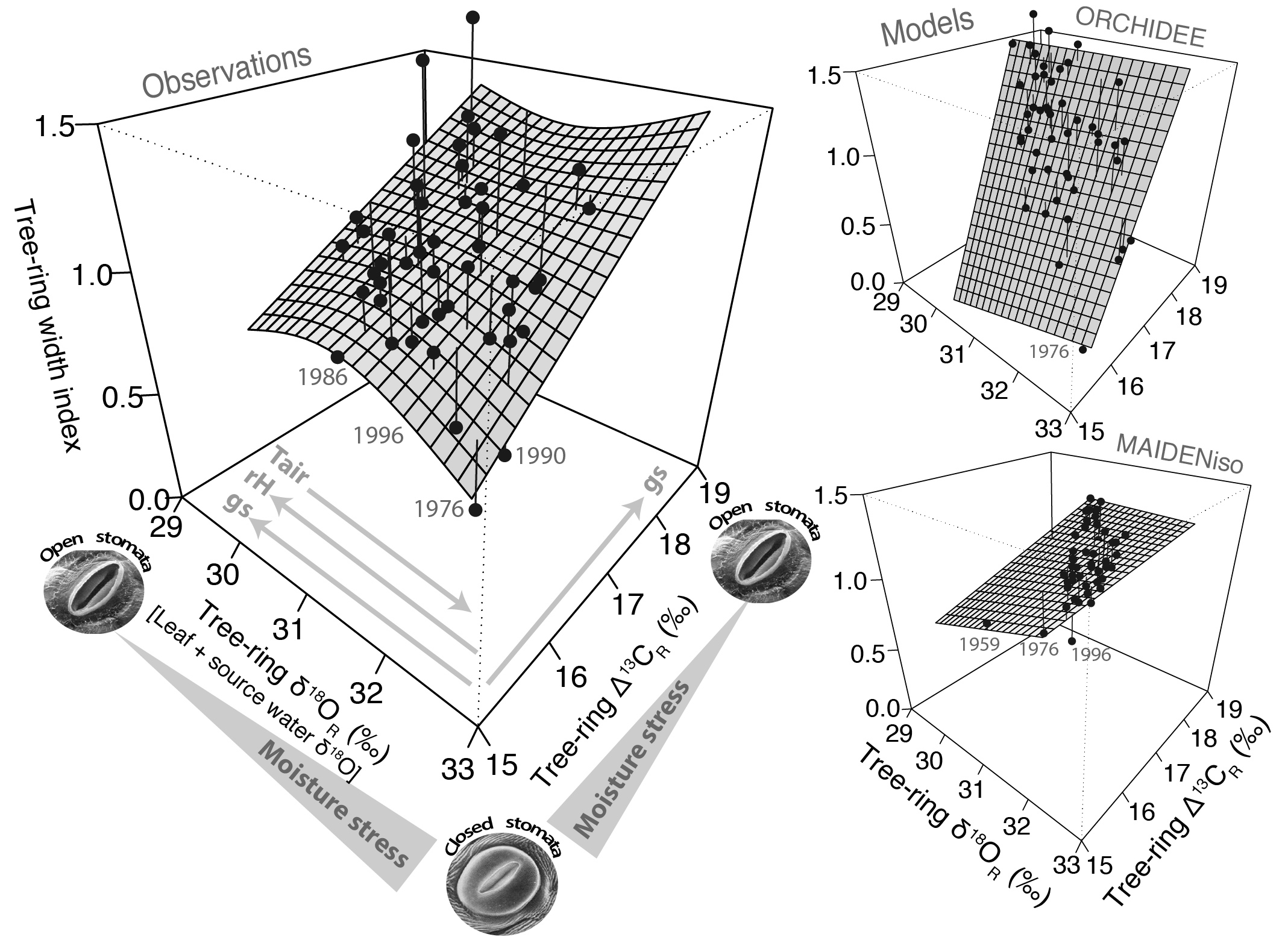
Triple growth-isotope tree-ring constraint to evaluate the integrated model responses as proposed by Barichivich et al. (2021).
Current land surface models rely on the flawed assumption that plant biomass growth depends directly on photosynthetic carbon uptake (i.e., carbon source limitation) instead of growth activity in meristematic plant tissues (e.g., wood formation), which has different environmental responses than photosynthesis. This has enormous consequences for forest-climate feedbacks and projected climate change.
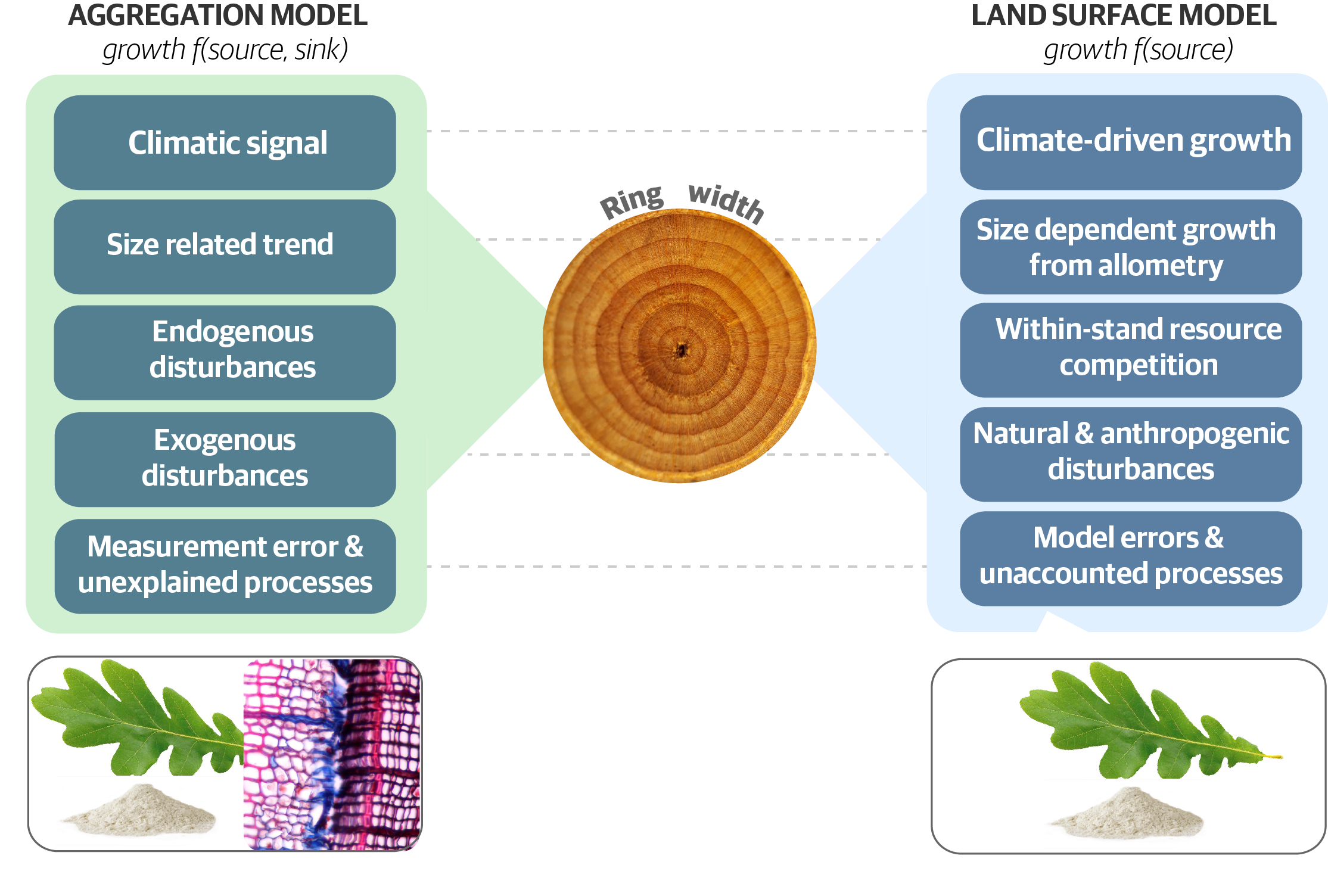
The aggregated conceptual model of tree-ring width (Cook 1987) and the analogue processes simulated by the ORCHIDEE global land surface model.
e. Urban climate and cities as global change experiments
Altered biogeochemical cycles, with higher CO2 concentrations and significantly stronger warming than in their rural surroundings make cities a natural climate change experiment. Current conditions in metropolitan regions simulate some of those that natural ecosystems will experience with similar intensity in the near future, notably warming. I am exploiting this feature of cities as a convenient alternative to expensive warming experiments.
I am testing if urban-rural gradients in mega-cities can be used to study short-term ecosystem responses (e.g., growth extremes) and long-term adaptations (e.g., water use efficiency, stomatal responses) to climate change factors, in particular to warming.
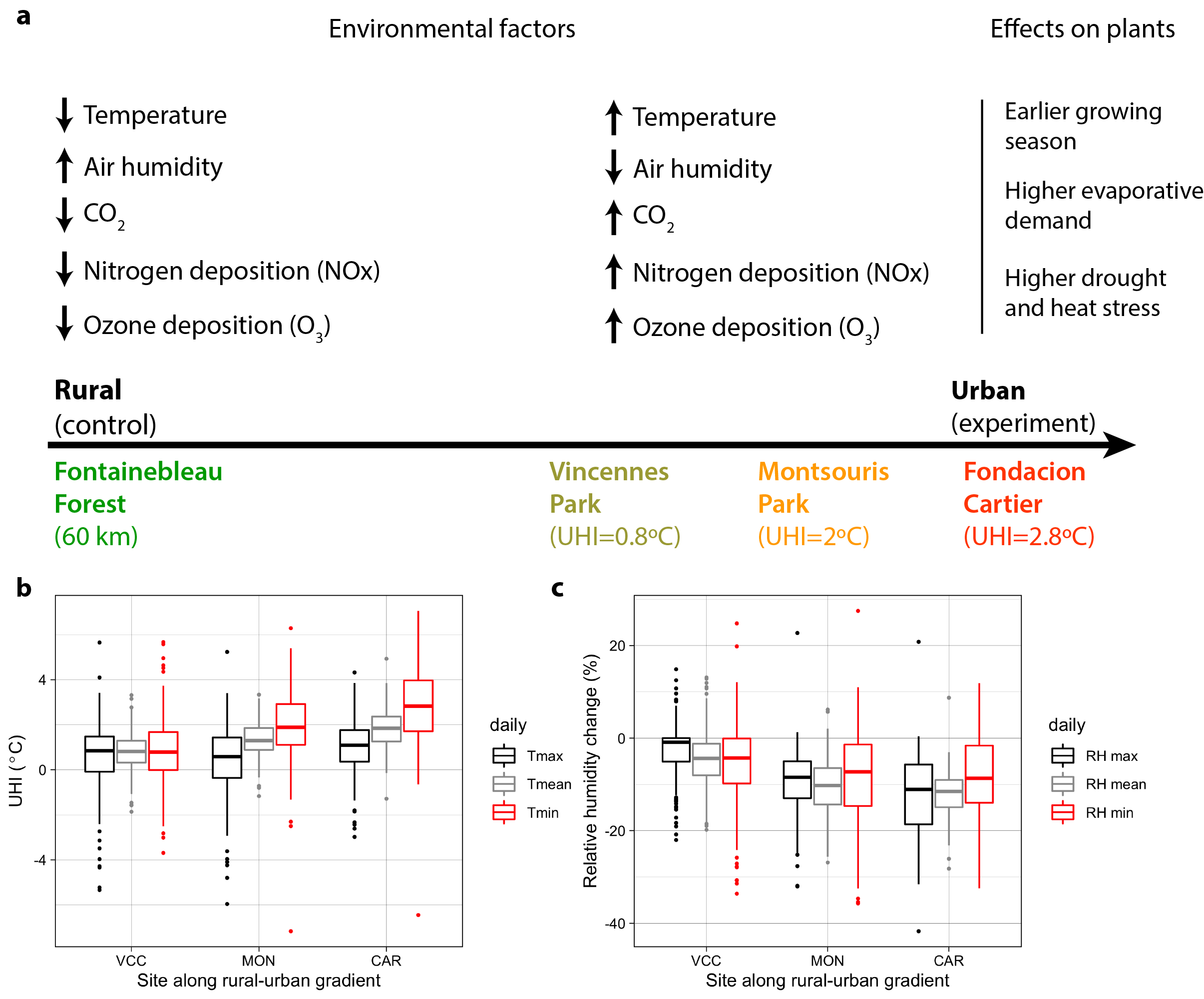
Illustration of the Fontainebleau-Paris rural-urban gradient as a global change experimental setup and the measured intensity of the urban heat island (UHI) and change in relative humidity along the gradient
Teaching and capacity building
I have dedicated a great deal of time to lead efforts for capacity building in order to attract talented students and start a modelling community in South America. Together with Prof. Alvaro Gutiérrez (University of Chile) we have been successful in obtaining grants for networking with the ETH (Harald Bugmann) and the LSCE (Philippe Peylin). As a result we have created an annual Summer School on Vegetation Dynamics to start exposing students to modelling from an early career stage (see picture below).
I have mentored several undergraduate students at the Universidad Austral de Chile and University of Chile. At PhD level, I have co-supervised Ms. Jina Jeong at VU Amsterdam (ongoing) and Dr. Alienor Lavergne formerly at LSCE on modelling tree growth.
Teaching in the field during the second Vegetation Dynamics Summer School in 2019.
Cultural creation
Books
- Urbina, X. and J. Barichivich (Eds), 2021. La sobrevivencia del alerce y su cultura: la historia de los alerzales de la Cordillera Pelada, Chile. Ediciones Universitarias de Valparaíso (in press).
Digital media
- Ethnographic documentary Los Vecinos del Abuelo. A portrait of the cultural heritage and current struggles of the inhabitants of the Alerce forests near the Alerce Costero National Park in southern Chile.
Social betterment
- Creation of the neighbours council Junta de Vecinos del Alerce Costero (2016) in the mountain community where I grew up.
- Directory member of the Corporación Alerce, an NGO that promotes the scientific knowledge and conservation of the remnants of native forests of the long-lived conifer Fitzroya cupressoides in the temperate rainforests of Chile.
